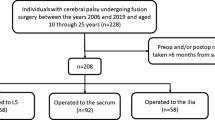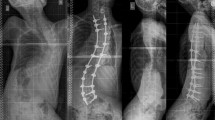Abstract
Background
Neuromuscular scoliosis is often treated with posterior spinal fusion, with or without anterior release, and either a same-day or staged, 2-day procedure.
Methods
We retrospectively reviewed 222 patients from a prospectively collected, multi-center database of patients with cerebral palsy scoliosis with 2-year follow-up. Baseline characteristics, perioperative, radiographic, and HRQoL measures were compared in six sub-analyses: (1) staged versus same-day surgeries, (2) posterior-only fusion (PSF) versus anterior–posterior spinal fusion (APSF), (3) same-day versus staged PSF, (4) staged versus same-day APSF, (5) same-day PSF versus same-day APSF, (6) staged PSF versus staged APSF.
Results
Staged patients had larger curves and more pelvic obliquity, longer anesthesia and surgical times, longer hospital and ICU stays (p < 0.001), and more days intubated (p = 0.021). The staged PSF group had larger curves (p = 0.006), longer anesthesia (p = 0.020) and surgeries (p = 0.007), hospital (p = 0.009) and ICU stays (p = 0.028) compared to same-day PSF. The staged APSF group had longer hospital (p < 0.001) and ICU stays (p = 0.004) and anesthesia and surgeries (p < 0.001). Same-day APSF was associated with larger curves (p < 0.002), longer anesthesia (p = 0.012) and surgeries (p = 0.042), greater residual curves (p = 0.035), and greater absolute correction (p = 0.007) compared to same-day PSF. The staged APSF group had longer anesthesia times (p < 0.001) compared to the staged PSF group. No sub-analysis revealed significant differences in baseline characteristics, complications, or HRQoL.
Conclusion
Staged and circumferential approaches tend to be used for greater deformity, but were not associated with superior deformity correction, and were associated with longer operative time, hospital stays, ICU stays, and days intubated. However, for the most severe deformity, other patient factors may play more important roles in treatment decisions given that patients treated with a staged PSF or an APSF, whether staged or not, were similar at baseline.
Level of evidence
III.
Graphical abstract
These slides can be retrieved under Electronic Supplementary Material.





Similar content being viewed by others
References
Hasler CC (2013) Operative treatment for spinal deformities in cerebral palsy. J Child Orthop 7:419–423
Vialle R, Thevenin-Lemoine C, Mary P (2013) Neuromuscular scoliosis. Orthop Traumatol Surg Res 99:S124–S139
Piazzolla A, Solarino G, De Giorgi S, Mori CM, Moretti L, De Giorgi G (2011) Cotrel–Dubousset instrumentation in neuromuscular scoliosis. Eur Spine J 20(Suppl 1):S75–S84. https://doi.org/10.1007/s00586-011-1758-x
Brown JC, Swank S, Specht L (1982) Combined anterior and posterior spine fusion in cerebral palsy. Spine 7:570–573
Tsirikos AI, Chang W-N, Dabney K, Miller F (2003) Comparison of one-stage versus two-stage anteroposterior spinal fusion in pediatric patients with cerebral palsy and neuromuscular scoliosis. Spine 28:1300–1305
Comstock CP, Leach J, Wenger DR (1998) Scoliosis in total-body-involvement cerebral palsy: analysis of surgical treatment and patient and caregiver satisfaction. Spine 23:1412–1424
O’Brien T, Akmakjian J, Ogin G, Eilert R (1992) Comparison of one-stage versus two-stage anterior/posterior spinal fusion for neuromuscular scoliosis. J Pediatr Orthop 12:610
Luhmann SJ, Lenke LG, Kim YJ, Bridwell KH, Schootman M (2005) Thoracic adolescent idiopathic scoliosis curves between 70 degrees and 100 degrees: is anterior release necessary? Spine (Phila Pa 1976) 30:2061–2067
Ferguson RL, Hansen MM, Nicholas DA, Allen BL Jr (1996) Same-day versus staged anterior-posterior spinal surgery in a neuromuscular scoliosis population: the evaluation of medical complications. J Pediatr Orthop 16:293–303
Gum JL, Lenke LG, Bumpass D, Zhao J, Sugrue P, Karikari I, Rahman R, Carreon LY (2016) Does planned staging for posterior-only vertebral column resections in spinal deformity surgery increase perioperative complications? Spine Deform 4:131–137. https://doi.org/10.1016/j.jspd.2015.08.005
Passias PG, Ma Y, Chiu YL, Mazumdar M, Girardi FP, Memtsoudis SG (2012) Comparative safety of simultaneous and staged anterior and posterior spinal surgery. Spine (Phila Pa 1976) 37:247–255. https://doi.org/10.1097/BRS.0b013e31821350d0
Reames DL, Smith JS, Fu K-MG, Polly DW Jr, Ames CP, Berven SH, Perra JH, Glassman SD, McCarthy RE, Knapp RD Jr (2011) Complications in the surgical treatment of 19,360 cases of pediatric scoliosis: a review of the Scoliosis Research Society Morbidity and Mortality database. Spine 36:1484–1491
Keeler KA, Lenke LG, Good CR, Bridwell KH, Sides B, Luhmann SJ (2010) Spinal fusion for spastic neuromuscular scoliosis: is anterior releasing necessary when intraoperative halo-femoral traction is used? Spine (Phila Pa 1976) 35:E427–E433. https://doi.org/10.1097/BRS.0b013e3181d9527e
Bowen RE, Abel MF, Arlet V, Brown D, Burton DC, D’Ambra P, Gill L, Hoekstra DV, Karlin LI, Raso J (2012) Outcome assessment in neuromuscular spinal deformity. J Pediatr Orthop 32:792–798
Modi HN, Hong JY, Mehta SS, Srinivasalu S, Suh SW, Yi JW, Yang JH, Song HR (2009) Surgical correction and fusion using posterior-only pedicle screw construct for neuropathic scoliosis in patients with cerebral palsy: a three-year follow-up study. Spine (Phila Pa 1976) 34:1167–1175. https://doi.org/10.1097/BRS.0b013e31819c38b7
Suk SI, Kim JH, Cho KJ, Kim SS, Lee JJ, Han YT (2007) Is anterior release necessary in severe scoliosis treated by posterior segmental pedicle screw fixation? Eur Spine J 16:1359–1365. https://doi.org/10.1007/s00586-007-0334-x
Zhang HQ, Wang YX, Guo CF, Tang MX, Chen LQ, Liu SH, Wang YF, Chen J (2011) Posterior-only surgery with strong halo-femoral traction for the treatment of adolescent idiopathic scoliotic curves more than 100°. Int Orthop 35:1037–1042. https://doi.org/10.1007/s00264-010-1111-8
Shi Z, Chen J, Wang C, Li M, Li Q, Zhang Y, Li C, Qiao Y, Kaijin G, Xiangyang C, Ran B (2015) Comparison of thoracoscopic anterior release combined with posterior spinal fusion versus posterior-only approach with an all-pedicle screw construct in the treatment of rigid thoracic adolescent idiopathic scoliosis. J Spinal Disord Tech 28:E454–E459. https://doi.org/10.1097/BSD.0b013e3182a2658a
Tokala DP, Lam KS, Freeman BJ, Webb JK (2007) Is there a role for selective anterior instrumentation in neuromuscular scoliosis? Eur Spine J 16:91–96. https://doi.org/10.1007/s00586-006-0105-0
Lonstein JE, Koop SE, Novachek TF, Perra JH (2012) Results and complications after spinal fusion for neuromuscular scoliosis in cerebral palsy and static encephalopathy using luque galveston instrumentation: experience in 93 patients. Spine (Phila Pa 1976) 37:583–591. https://doi.org/10.1097/BRS.0b013e318225ebd5
Takeshita K, Lenke LG, Bridwell KH, Kim YJ, Sides B, Hensley M (2006) Analysis of patients with nonambulatory neuromuscular scoliosis surgically treated to the pelvis with intraoperative halo-femoral traction. Spine (Phila Pa 1976) 31:2381–2385. https://doi.org/10.1097/01.brs.0000238964.73390.b6
Dove J, Hsu LC, Yau AC (1980) The cervical spine after halo-pelvic traction. An analysis of the complications of 83 patients. J Bone Joint Surg Br 62-B:158–161
Buchowski JM, Bhatnagar R, Skaggs DL, Sponseller PD (2006) Temporary internal distraction as an aid to correction of severe scoliosis. J Bone Joint Surg Am 88:2035–2041. https://doi.org/10.2106/JBJS.E.00823
Nishnianidze T, Bayhan IA, Abousamra O, Sees J, Rogers KJ, Dabney KW, Miller F (2016) Factors predicting postoperative complications following spinal fusions in children with cerebral palsy scoliosis. Eur Spine J 25:627–634. https://doi.org/10.1007/s00586-015-4243-0
Acknowledgements
Research grants from DePuy Synthes Spine and from K2M to Setting Scoliosis Straight Foundation for Harms Study Group research efforts were received in support of this work.
Author information
Authors and Affiliations
Consortia
Corresponding author
Ethics declarations
Conflict of interest
Disclosures relevant to submitted: Grant from the Setting Scoliosis Foundation, with research grants from DePuy Synthes Spine and K2M in support of Harms Study Group research. Disclosures outside of submitted: Consultancy/Personal fee—DePuy Synthes Spine, DePuy Synthes Canada, Cubist, K2M, Ellipse Technologies Inc., NuVasive, Medtronic Inc., Orthopediatrics, Stryker, Globus Medical; Royalties—DePuy Synthes Spine, Thieme Publishing, K2M; Investments/Options—Electrocore; Board membership—Setting Scoliosis Straight Foundation, Rady Children’s Specialists, AAOS, Scoliosis Research Society, International Pediatric Orthopedic Think Tank, Cubist, POSNA; Editorial Boards—JBJS-American, Spine Deformity; Other Financial/Research/Institutional Support—DePuy Synthes Spine, EOS Imaging, NuVasive, Orthopediatrics, K2M, Alphatech, Medtronic Inc. Patents/Product Development—DePuy Synthes Spine, Inc., K2M.
Electronic supplementary material
Below is the link to the electronic supplementary material.
Rights and permissions
About this article
Cite this article
Jackson, T., Yaszay, B., Sponseller, P.D. et al. Factors associated with surgical approach and outcomes in cerebral palsy scoliosis. Eur Spine J 28, 567–580 (2019). https://doi.org/10.1007/s00586-018-5745-3
Received:
Revised:
Accepted:
Published:
Issue Date:
DOI: https://doi.org/10.1007/s00586-018-5745-3




